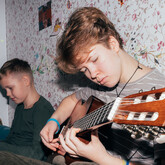It's the end of March when STIM-Magasinet meets up with composer Anna Eriksson at Rosendal's Garden on the island of Djurgården in Stockholm. The cold is biting, but spring is in the air. I'm holding Anna's jacket and bag while she stands in a field having her photo taken, a heavy mist in the background. Viktor, the photographer, is mumbling almost manically about "magical light" and doesn't seem to want to stop shooting.
"It's okay, I can get like that when I'm inspired," says Anna, when a short while later I point out that it's a little too cold to be standing outside without a jacket.
Eventually, we make our way into the hothouse, which is also home to a coffee shop, to sit down for the interview.
"I'm often inspired by things other than music. It could be a line of text or the structure of a DNA molecule. A DNA sequence is composed of four building blocks that in different ways can be 'translated' into musical structures. I've printed a DNA code that I sometimes look at and find patterns that can be of interest in musical terms. It can provide a starting point for a piece of music, a kick start."
"I gather material and ideas, Google stuff, and read. A lot goes on in my head before I try things out on the piano or computer," says Anna.
Anna puts her bag on the table and retrieves a large bundle of papers that she starts leafing through.
"At the moment, I'm writing a piece for a soprano and the harp based on this text. It's a long poem describing the goddess Inanna's descent to the underworld. It's one of the oldest texts in existence and is also great poetry; it ignites a lot of ideas."
Anna has lived in Gothenburg on Sweden's west coast for the past 25 years. Bringing her work material all the way to Stockholm, even though she plans to be away for the entire weekend, is something that she can kind of thank film director Ingmar Bergman for.
"You have to be a bit pragmatic to make a deadline and you have to get to know yourself. I know that it takes me about two months to write a music piece, regardless of its size. The piece I'm working on now has to be finished by the end of May, so I need to get on with it."
"Even if I don't have any ideas, I sit and go through the motions of composing for a few hours every day. After a while, things start happening. It's a classic method. Ingmar Bergman wrote for two hours in the morning every day, regardless of whether anything became of it. I usually think like that, IB2, Ingmar Bergman two, and sit for two hours."
This fall, the fruits of these many hours of labor will be gathered in a portrait album.
"I've written a great deal of different types of chamber music. In recent years, I've felt strongly compelled to get my act together and gather some of my favorite works with a few of the musicians I've worked with a lot in recent years."
Last fall, Anna did something about it. She put together an ensemble comprised of Åsa Nordgren, soprano, My Hellgren, cello, Anna Svensdotter, flute, and Sara Sjödahl, prepared piano. The group was named Ghost Inside Ghost, the title of one of Anna's pieces.
"I rearranged a great deal of old works to suit the composition and wrote some new stuff especially for this ensemble. The music was recorded this past winter and will be released on the Kning Disk label."
Anna began her musical career as a guitarist.
"I played a lot of folk music and jazz, and wrote my own songs. But then I noticed that the tunes became increasingly complicated and were no longer simple songs. I realized that my passion was for composition, not sitting on stage playing."
This interest in writing music resulted in Anna first applying to the Gotland School of Music Composition and later studying composition for four years at the Academy of Music and Drama at Gothenburg University.
"Somehow, I combined all of my different interests and condensed them into composition."
Isn't it a big step from strumming a guitar to writing for the marimba?
"Yes, but not really. I'm a musician at heart, so I can put myself in a musician's shoes. I'm happy to discuss things with them and I'm open to any changes they suggest."
Do you put your foot down if the musicians want to change too much?
"It depends, sometimes I do. Some pieces offer a lot more room for improvisation and free interpretation. Other pieces are strictly noted. Musicians often have clever solutions to technical problems."
Otherwise, clever solutions are something Anna is known for. Her works often transpire in the realm between sound art and chamber music.
"That's a fuzzy description; what's a sound artist? Being a composer is being a sound artist. It's all sounds and notes. I often use sound objects in my compositions. Certain works are some kind of mix between a concert and an installation."
One example of this is Anna's chamber opera Opera Lingua, which premiered in 2011. This opera is based on dialogs from old language courses from the 1950s, '60, and '70s.
"There's a great deal of drama in those dry texts that's very funny, yet also captivating and sad."
The opera is set in a classroom and several common objects from that environment are used as sound objects.
"I used sounds from items such as a pencil sharpener, a coffee grinder, rustling papers, and a tabletop fan. It was something like a sound artwork blown up into an absurd opera."
"In another piece I've written, Ping and Pong, for piano and recorder, you prepare the piano with dozens of table tennis balls. It's like a popcorn maker when the pianist starts hitting the keys; extremely visual while also broadening the sound of the piano. But the visual and spatial are not ends in themselves; they have to be bound to the music."
Anna mostly works on commission for different ensembles, which in turn are dependent on funding from the Swedish Arts Council and similar institutions.
"Doing this doesn't lead to financial success, but it's very difficult to stop once you've started. You make ends meet with a combination of commissioned works, work stipends, and second jobs. And occasional STIM royalties."
Anna is a qualified guitar teacher and has at times, such as now, taught students at a culture school.
Does your day job provide inspiration for composing?
"I currently work one day a week at the Culture School in Örgryte/Härlanda in Gothenburg. There are some nice musical moments with the children, with interesting musical creations while they discover their instruments and before they develop preconceived ideas about how they should sound. Also, being a guitar teacher feels very down to earth and concrete. 'This is how you play D7.' "
If you could choose, what would be your dream scenario?
"I live very much in the here and now, I don't really have large-scale visions. I'm grateful that there are musicians who want me to write for them and who want to collaborate on different projects. One wish would be a little more long-term stability. To be able to take the time to write a longer musical work. To perhaps use the myth about Inanna in a larger composition."
When we leave Rosendal's Garden, the mist has lifted and it no longer feels as though spring is in the air. The magical light has dimmed and the falling rain has turned Djurgården a shade of gray.
Anna Eriksson on…
…the art music scene in Gothenburg
"There are several good promoters: Geiger, Levande musik, Koloni, and Brötz.
…what music she listens to
"I'm always a little embarrassed when I'm asked that question. I don't actually listen to much music. If I'm going to listen to newly composed music, I'd rather hear it live."
…how she would like others to listen to her music
"I don't want people to sit and think, 'Oh, that's clever' when they listen to my music; I want to give them energy. I want my music to be easily accessible, but always with more to discover under the surface."
…STIM
"It's good that STIM exists. To know that there's such a big organization looking after our interests."
Age: 51
Lives in: Gothenburg
Family: Partner Sven, miniature poodle Dizzy, mom, dad, one sister, two brothers.
Current: Ghost Inside Ghost – portrait album of chamber music due this fall.
Five composers that inspire Anna:
Bach
Henry Purcell
David Bowie
Joni Mitchell
Elvis Costello
Stim facts:
Number of registered pieces of work: 80
First registered piece:
Sensommarpolska
Most played:
Moose Imitating Moss
Navkapsel
Under solen


